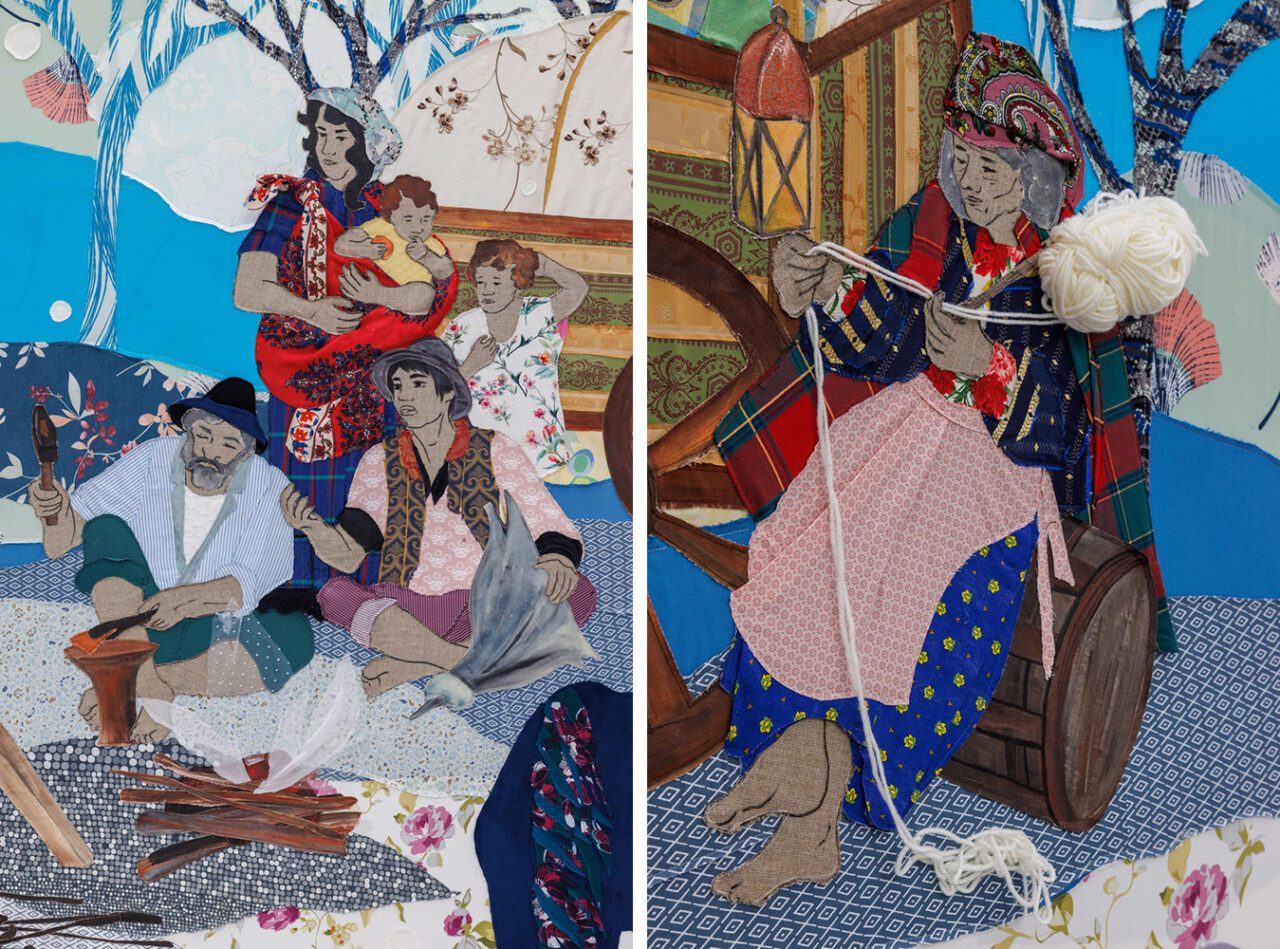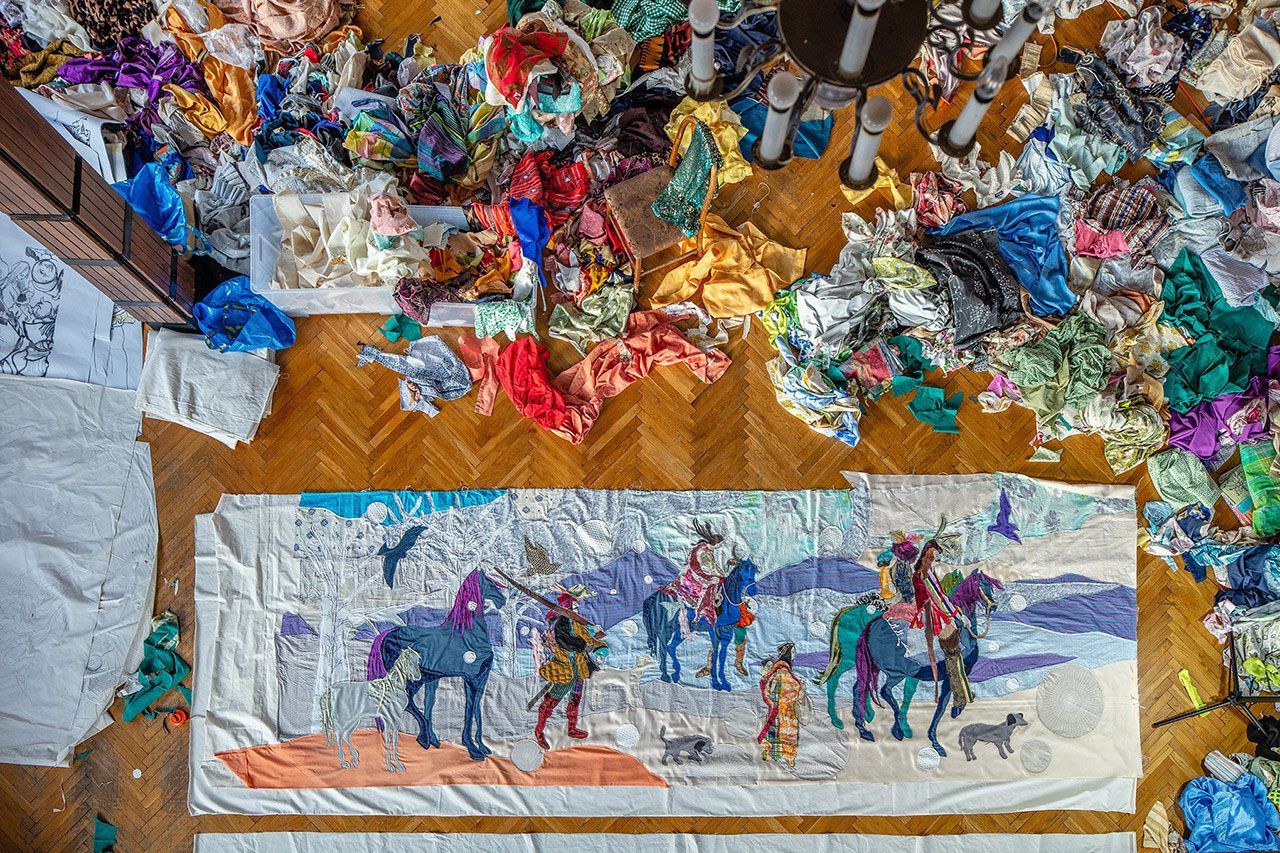PRESENTATION:Małgorzata Mirga Tas-Tełe Ćerhenia Jekh Jag
Małgorzata Mirga-Tas’s work is dedicated to the world of Roma culture. In her detailed, realistic depictions, she portrays everyday scenes—people smoking a cigarette, playing cards, or hanging up laundry. Her portrayals adopt the perspective of “minority feminism,” consciously advocating for women’s strength while also acknowledging the artist’s own cultural roots. She was the official Polish representative at the 59th Venice Biennale in 2022, the first Roma artist to represent any country.
By Efi Michalarou
Photo: Kunsthaus Bregenz Archive
In her solo exhibition “Tełe Ćerhenia Jekh Jag” (Under the Starry Heavens a Fire Burns), Małgorzata Mirga-Tas transforms the gallery into a realm where myth and material collide. Created specifically for this space, her large-scale textile works and sculptural installations—figures of men and bears known as the “Jangare”, shaped from wax and coal—evoke both the mystical and the deeply human. Drawing from Roma mythology, these works simultaneously reflect contemporary struggles and resilience. Mirga-Tas first gained international acclaim at the 2022 Venice Biennale, where she reimagined the Polish Pavilion with monumental textile compositions. Inspired by the Renaissance frescoes of the Palazzo Schifanoia in Ferrara, her tripartite structure mirrored the calendar’s visual logic. The central band of zodiac signs is bordered by near life-size portraits; above them, a vivid frieze chronicles the history and migration of the Roma people—told through dynamic depictions of traditional dress, animals, and sweeping landscapes. Below, scenes of daily life unfold: moments of community, sisterhood, care, and family—rendered with warmth and immediacy. By reclaiming and reconstructing their own narratives, the Roma community in Mirga-Tas’s work actively resists the centuries of exoticization and marginalization imposed upon them. Her fabric collages draw on Roma traditions of craft, yet go beyond homage. Through her hands, textile becomes a form of political resistance. In one striking self-portrait, she depicts herself sewing alongside other women—not as passive figures, but as empowered agents of creativity and change. Here, labor is not a burden; it becomes a source of belonging, identity, and strength. On the first floor, the monochrome “Jangare” sculptures create a compelling contrast to the colorful textile works. These imposing, faceless figures—cast in wax but appearing weighty like stone—exude both protection and vulnerability. “They radiate charm but also guard people,” says Mirga-Tas. Their muscular forms recall ancient idols or propagandistic statuary, but unlike heroic monuments, the “Jangare” are hunched, anonymous, and quiet—intimate witnesses rather than conquerors. Behind them, textile panels depict domestic scenes of women sewing and weaving Jangare, weaving myth into matter. The second floor centers on the image of the blacksmith, inspired by a poem by Roma writer Jan Mirga. “My grandfather was a blacksmith,” the artist recalls, “and this room includes portraits of him and my uncle Augustin.” The poem becomes both a literal and metaphorical core of this section. The act of forging metal—a “lump of expressionless iron” transformed by fire—serves as a powerful allegory for Roma endurance. Amid poverty and exclusion, strength and artistry emerge. The tools of the trade—hoes, axes, horseshoes—symbolize both survival and the creativity required to persist. The poem interlaces themes of longing, dance, the moon, and intoxication with symbols of liberty like the peregrine falcon, a recurring motif in Mirga-Tas’s work representing pride, freedom, and fierce vitality. Ascending to the top floor, visitors enter a world infused with magic and mythology. Here, three monumental bears—crafted from wax—stand sentinel. These creatures, appearing elsewhere in her work as companions or guardians, blur the boundaries between human and animal, dream and reality. Nature is rendered not as static background, but as a living archive—where ritual, memory, and imagination intertwine. Through this deeply personal and politically charged body of work, Małgorzata Mirga-Tas weaves a singular visual language: one that merges ancestral knowledge with contemporary narratives, craft with concept, myth with resistance. Her art speaks of identity, agency, and the quiet yet powerful act of remaking one’s world, again and again, in the face of adversity. Also, Małgorzata Mirga-Tas is displaying on the six panels a selection of images of her textile works and sculptures created between 2016 and 2023. Mirga-Tas’s works address the history, culture, and traditions of the Roma communities in her native Poland. The illustrations show traditional stories, everyday scenes, and landscapes that have become pictures here.
Photo: Behind the Scenes: Małgorzata Mirga Tas, at her studio, 2022, Photo: Daniel Rumiance, Courtesy the artist and Kunsthaus Bregenz
Info: Kunsthaus Bregenz, Karl-Tizian-Platz, Bregenz, Austria, Duration: 7/6-28/9/2025, Days & Hours: Tue-Wed & Fri-Sun 10:00-18:00, Thi 10:00-20:00, www.kunsthaus-bregenz.at/











